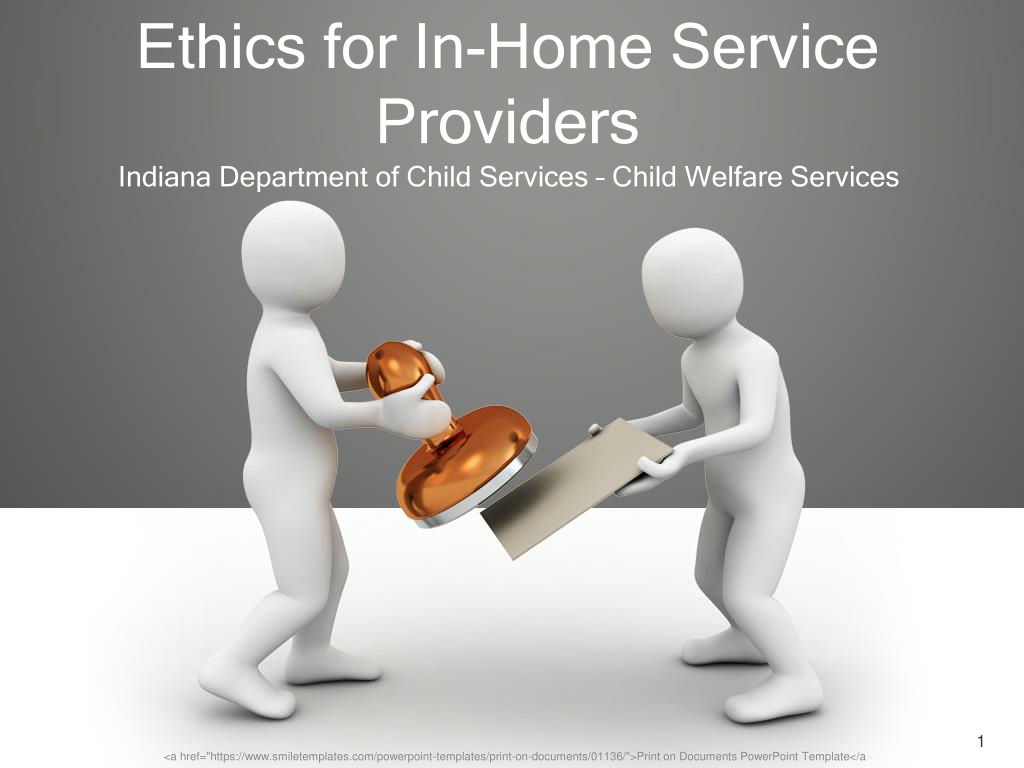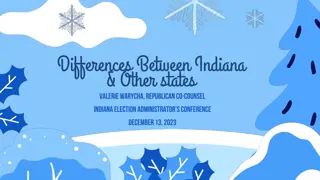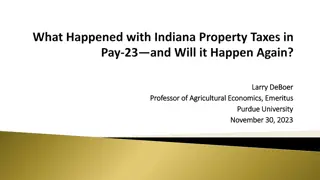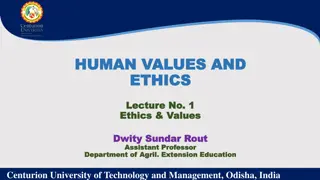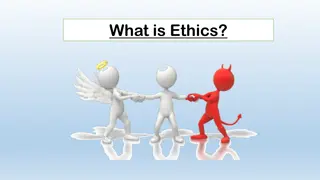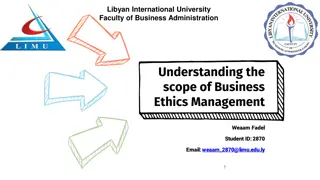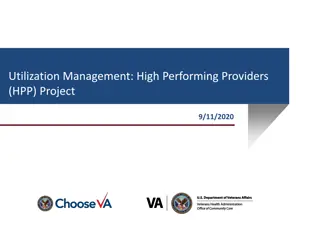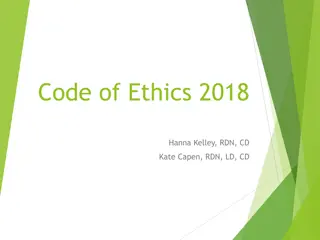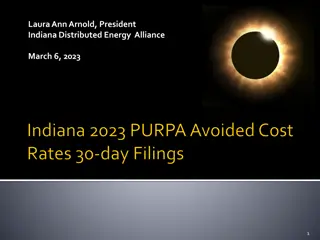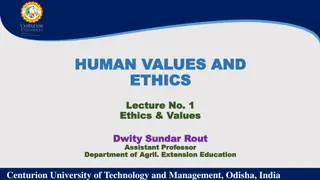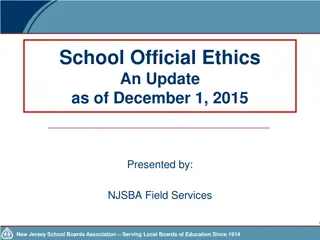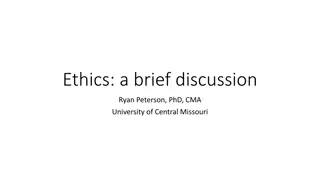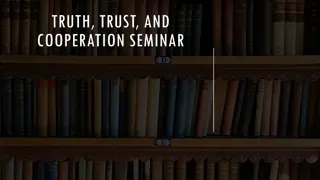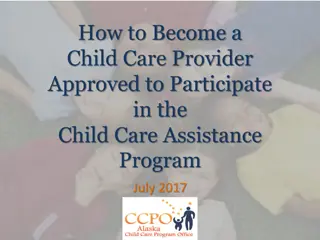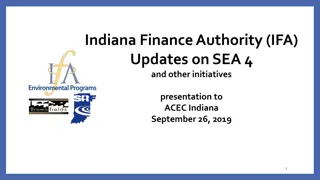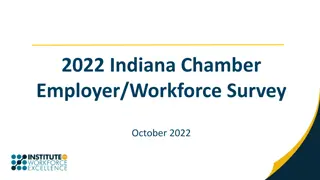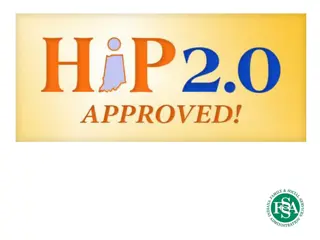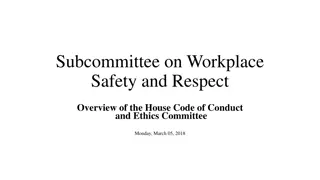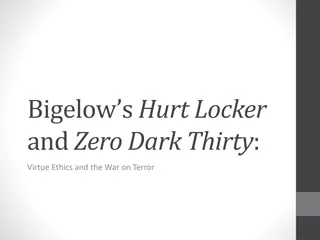Ethics Training for In-Home Service Providers in Indiana
This training module focuses on ethical considerations for in-home service providers in Indiana, specifically in the context of child welfare services. It includes interactive activities and discussions on agency values, metaethics, and normative ethics theories to guide decision-making in ethical dilemmas. Participants are encouraged to apply the concepts learned to real-life scenarios to enhance ethical decision-making skills.
Download Presentation

Please find below an Image/Link to download the presentation.
The content on the website is provided AS IS for your information and personal use only. It may not be sold, licensed, or shared on other websites without obtaining consent from the author. Download presentation by click this link. If you encounter any issues during the download, it is possible that the publisher has removed the file from their server.
E N D
Presentation Transcript
Ethics for In-Home Service Providers Indiana Department of Child Services Child Welfare Services 1 <a href="https://www.smiletemplates.com/powerpoint-templates/print-on-documents/01136/">Print on Documents PowerPoint Template</a>
Materials Please have the following items available for your use during this presentation: Plenty of paper and a writing utensil Your agency Code of Conduct and/or Core Values Statement After reviewing each slide and completing the instructed notes or activities, click anywhere on the slide to advance. 2
Think About It! 1. Consider a current, past, or hypothetical ethical dilemma. 2. This can be a personal experience, one you have heard about, or something you are concerned may arise in the future. 3. Write down your dilemma on a piece of paper. You only need to write enough information to remind yourself of the dilemma later. 4. Consider your dilemma as you work through the presentation today. At the end of the presentation, you will be prompted to use tools developed today to work through the dilemma. 3
Agency Values Review the DCS Mission, Vision, and Values: http://www.in.gov/dcs/files/MissionVisionValu esPosterColor.pdf Compare this to the Mission, Vision, and Values of your agency. 4
Agency Values (continued) You likely notice similarities in the two agency Mission, Vision, and Value statements. These statements can establish a foundation for ethics within your agency and in your work with children and families. As you work through the presentation today, consider how these statements may guide your decisions. 5
Metaethics Noun Noun The philosophy of ethics dealing with the meaning of ethical terms, the nature or moral discourse, the foundations of moral principles www.dictionary.com/browse/metaethics This is often used as the criteria to determine what is ethically right and wrong, based on ethical theories and principles. Consider, Would other people in my field think the way I do about this situation? 6
Normative Ethics Deontological Theory Deontological Theory Certain actions are either right or wrong, without regard for their consequences. These are usually addressed with rules, policies, and procedures within an organization. Teleological Theory Teleological Theory The rightness of an action is determined by the goodness of its consequences. This idea accounts for specific circumstances. The correctness of the action depends on the situation. 7
Deontological or Teleological Ethics Activity Review each scenario and determine if the ethical dilemma is Deontological (clear right or wrong solution) or Teleological (solution depends on the circumstances). Click the screen anywhere to reveal the answer, click again to progress to the next scenario. 8
Spreading Holiday Cheer It is near the end of the calendar year, and you are nearing the end of your work with a family. The family knows the closure of their DCS case is largely dependent on your report to the FCM, due in two weeks. At the end of your session, mom talks about all the progress the family has made, and reminds you to write those things down for the FCM so that we can get this over with . As you are about to leave, the oldest child wishes you Happy Holidays and hands you a gift card worth $50 to your favorite restaurant. Do you accept the gift? Deontological Your agency likely has policy regarding accepting gifts from clients. Since the gift was offered soon after a conversation regarding case closure, it could be thought that the gift was a bribe to create a positive report in order to close the DCS case. A gift that could be considered bribery by anyone should never be accepted. 9
A New Client You are visiting a new client s family in their home for the first time. After visiting with the father and children, the mother arrives home to greet you. You immediately recognize mother as a high school classmate. Since she is now married, you did not recognize the name before seeing her in person. Mother indicates that you look familiar, but does not recall you were classmates. You were not particularly close to this person in high school and do not think it will be a barrier in your relationship. Should you continue your work with this family, or ask a coworker to take this client? Teleological There are several factors that would determine whether or not you should continue working with this family. Will your prior relationship cause a barrier? Do you know information about the family that may lead to a bias? Are there other staff available to cover or trade new cases with? In this situation, talk to your supervisor before making a final decision. 10
The Over-Sharing Coworker You have a new coworker who is excited about the work your agency does with families. You like this coworker and have tried to mentor her, you even connected with her on social media. One evening you see a post from your coworker talking about the great progress the Montez family is making, and how much she enjoys her job. The post is positive, does that make it OK to share? Deontological It would never be appropriate to share information about families or clients on social media. Even if the sharing is positive, it is a violation of the client s privacy to share any part of their situation publicly. 11
The Over-Sharing Coworker You have been working with a single mother and her children for about six weeks. Mom is now employed, cooperating with services, and is making great progress. In a recent session, mom tells you that she has a warrant out in regards to unpaid speeding tickets. She is saving money from each paycheck to pay the fines, but is concerned that she will be arrested before she has the funds she needs. Mom is concerned that you are going to turn her in now that you are aware of the warrant. Teleological Your agency may have a policy regarding notifying authorities in this regard. If that is the case, this situation would be Deontological a clear answer is provided. Otherwise, consider child safety. Is mom driving with the child on a suspended license? Can you explain the consequences to that and encourage her to find other transportation? Are there other safety concerns related to this issue? Does mom have a clear plan to take care of the fees? It is possible that you may not need to turn her in if it would be further detrimental to the family and does not compromise child safety. 12
Good Work! The purpose of the activity is not to memorize the two terms, but to understand that some ethical dilemmas have a clear answer, and others depend on the situation. 13
Standard of Care What an ordinary, reasonable, and prudent colleague with the same or similar training would do under the same or similar circumstances. Notice this goes beyond the boundaries of your agency to include colleagues in similar agencies, practices, and career fields. 14
Standard of Care Substantive: Substantive: Refers to specific ethical issues such as handling confidential information, obtaining informed consent, managing boundaries, and terminating services. For example it is widely agreed upon that a worker would not share private information regarding one client with another client for any reason. 15
Standard of Care (continued) Procedural: Procedural: How staff in your field or a similar field who have similar training would process an ethically complex situation. For example professionals in child welfare services consult with supervisors regularly in regards to specific details of each case. 16
Standard of Care (continued) Child Welfare professionals generally agree that these key elements are included in the procedural standard of care: procedural standard of care: Consult colleagues and supervisors Consult relevant policies, regulations, and laws Consult relevant codes of ethics and ethics committees Consult lawyers if legal issues are involved Document the process 17
Professional Negligence Professional Negligence occurs when an employee has a duty breaches that duty breaches that duty in a way that causes harm, damage, or injury causes harm, damage, or injury. There must be a clear connection between the breach of the duty and harm caused (no other way to explain the harm). has a duty, and clear connection 18
Forms of Negligence Malfeasance: Malfeasance: Taking part in a wrongful or unlawful act. duty that is part of your job. Nonfeasance: Nonfeasance: Failure to complete a Misfeasance: Misfeasance: Committing an otherwise proper act in an improper (illegal or harmful) way. Carrying out an illegal act that may have legally been performed another way. substances to clients. notes when the employee did not see the family. Example: Example: Selling controlled Example: Example: Falsely entering visitation Example: Example: Taking wards home with you in an emergency situation rather than contacting DCS for removal Click anywhere to progress to next definition 19
Negligence Activity Review each scenario and determine if the worker was negligent in their actions. If so, is the negligence Misfeasance (acting incorrectly) Malfeasance (willfully doing something unethical or illegal) or Nonfeasance (not performing an expected duty). Click the screen anywhere to reveal the answer, click again to progress to the next scenario. 20
Negligence Scenario #1 Markus is a new therapist with the agency and is struggling to manage his caseload. During a closing session, his client makes vague references to domestic violence occurring in her home. Markus hears the comments, but does not respond. Markus was looking forward to closing this case and using the extra time to catch up on paperwork. NONFEASANCE: Markus knew he needed to take action by asking more questions about the domestic violence and/or completing a DV assessment. Markus willingly chose not to provide the service. 21
Negligence Scenario #2 Destiny is a Home Based Caseworker with the Sanchez family. When Destiny arrived for her meeting this week, the family did not answer the door. Destiny waited 15 minutes and tried again, called both parents (leaving a voicemail), and left a note on the door. The meeting was in the evening, so Destiny left a voicemail for her supervisor, but is concerned that she may be reprimanded for not following through with services she is contracted to provide NO NEGLIGENCE: Destiny made an appointment and made several attempts to contact the family. She also updated her supervisor on the issue. Destiny should contact the family as soon as possible to reschedule and notify the FCM if they are not compliant. 22
Negligence Scenario #3 Amelia supervises visits at her agency for the Baker family. During a CFTM the team agreed that the mother would be the ONLY adult to come to the visits (no friends allowed). Amelia and mom have been building a bond, so when mom brought her new boyfriend to the visit, Amelia did not want to make him leave. Amelia decided that is was important for the boyfriend to get to know the kids if he is going to be a part of their lives. What Amelia does not know is that the boyfriend is a registered sex offender. MISFEASANCE: Amelia should not have allowed the additional person to visit. Amelia should have contacted the team and completed (or requested completion of) appropriate background and criminal history checks before allowing the boyfriend to participate in visits. 23
Negligence Scenario #4 Drake provides transportation for two children to visit with their mother. Visits are unsupervised, but Drake really likes the family so he takes the kids inside and stays to chat with mom for a while. Drake has noticed the mom seems interested in him. The children will be reunified with mom soon anyway, and they will no longer need transportation. Drake asks the mom out on a date, and she agrees to go to dinner with him this weekend. MALFEASANCE: It is never appropriate for child welfare professionals to engage in personal, intimate relationships with a client. 24
Good Work! Again, the purpose of the activity is not to memorize these terms, but to understand that there are a variety of types of professional negligence that may occur. It is important to avoid all of them! 25
Dual (or Multiple) Relationships Participating in more than one relationship with a client is not always an ethical violation, but the professional must be very careful. Boundaries need to be established between the professional and the client to avoid a violation of commonly accepted ethical standards. When boundaries are violated, it is commonly in the areas of intimacy, personal benefit, emotional needs, altruism, or unavoidable circumstances. The following slides will overview each theme. 26
Boundary Violations: Intimate Relationships Sexual relationships Intimate contact Providing services to former lover Sexual relationships with clients relatives or acquaintances Sexual relationships with supervisees, trainees, colleagues Intimate gestures such as notes or gifts Anything that somehow suggests the relationship is more than professional is a boundary violation. 27
Boundary Violations: Personal Benefit Monetary gain (paid supervision, overseeing client affairs, etc.) Business and financial relationships Goods and services (Trading) Advice and services (e.g. client who is a mechanic) Favors, gifts, meals, social invitations Conflicts of interest (soliciting clients for your direct sales business) 28
Boundary Violations: Emotional Needs Friendships with current or former clients Community contact with clients (organizations or groups) Self-disclosure Unconventional Interventions Affectionate communications 29
Boundary Violations: Altruism Giving clients gifts Offering clients favors Meeting clients in social settings Providing personal contact information to clients 30
Boundary Violations: Unavoidable Circumstances Geographical proximity Cultural, social, ethnic gatherings Conflicts of interest Professional encounters Social encounters 31
Examine Your Boundaries The following are questions to ask yourself to help determine whether an action does or does not fall within the professional role of the home- based service provider. seem at least partially professional? significantly, and negatively impacted? professional? Given the opportunity, did the Is there a high probability that the action will be viewed or credibility of the home-based fail to clarify that the action was Does the behavior, on its face, Is there a high probability that clients will be directly, linked to a role played by home- based service providers? behavior is personal or receiving services? a personal one? Does the action threaten the home-based service provider Is the action under discussion Has a client expressed confusion about whether the discovered by clients currently service provider? Click anywhere to begin, and again to advance to the next question. 32
Tips to Avoid Crossing Boundaries Establish boundaries early in the relationship, such as What will we see each other in public? Consider whether the dual relationship in any form is warranted or justifiable. Pay special attention to incompatible roles (secretary, student, faculty member, etc.). Consult with colleagues, ethical standards, agency policies, regulations, statutes. Work with your supervisor when boundary issues (beyond typical situations) occur and risk is evident. Document key aspects of decision-making processes and consultations. 33
Documentation Tips Know and understand your agency s documentation policies Balance information to ensure best interests of client, colleagues, agency, and courts; be thorough without providing too many details Avoid defamation (slander and libel) Handle errors with great care Avoid ambiguous phrases and abbreviations Include evidence to support statements Document what you know, not what you think Respond to subpoenas according to your agency policy Handle personal notes carefully Be familiar with laws, regulations, and ethical standards 34
Review Your Ethical Dilemma Recall the ethical dilemma you noted at the beginning of this training. Work through the questions on the following slides, making notes as you go. At the end of the process, you should have a better idea of the most ethically responsible solution, or know who to talk to next for guidance. Click the screen anywhere to progress to the next question. 35
Review Your Ethical Dilemma Is the dilemma Deontological (clear right or wrong) or Teleological (solution depends on circumstances)? 36
Review Your Ethical Dilemma Have you considered Procedural Standards of Care, such as consulting coworkers, policy, ethics, and legal? Does your agency have documented policy and/or procedures to address your ethical dilemma? Consider a colleague you trust. How would they handle a similar situation? Can you talk to them about your dilemma? Have you talked to your supervisor about it? 37
Review Your Ethical Dilemma Is any form of Negligence involved? Misfeasance: Misfeasance: Completing a task improperly that could have otherwise been completed correctly Malfeasance: Malfeasance: Acting in an unlawful or wrong manner Nonfeasance: Nonfeasance: Failure to complete a task expected of you 38
Review Your Ethical Dilemma Can you identify any past or potential boundary violations in your ethical dilemma? How can you work with the client and/or your supervisor to address those violations now? 39
Review Your Ethical Dilemma Have you thoroughly and properly documented your interactions with the client, including your knowledge and supporting evidence? Remember to be careful in your language and content in order to protect your client! 40
Summary In-Home service providers work intensely with families in their own homes and build relationships with clients. Ethical issues in this field can be complicated, and there are often no clear answers. This training is not intended to teach you how to avoid ethical dilemmas, however, you now have knowledge and tools to address ethical issues as they arise in your work. Remember to consult your agency s policies, ethical standards, your colleagues, and of course, your supervisor! Thank you for participating! 41
Bibliography Frederic G. Reamer, Risk Management in Social Work: Preventing Professional Malpractice, Liability, and Disciplinary Action. New York: Columbia University Press, 2015. Frederic G. Reamer, Boundary Issues and Dual Relationships in the Human Services. New York: Columbia University Press, 2012. Ethical Risk Management Issues in Social Work. Reamer, Frederic G. October 2005 www.dictionary.com/browse/metaethics http://www.in.gov/dcs/files/MissionVisionValuesPosterColor.pdf PowerPoint Background Template: <a href="https://www.smiletemplates.com/powerpoint-templates/print- on-documents/01136/">Print on Documents PowerPoint Template</a> 42
